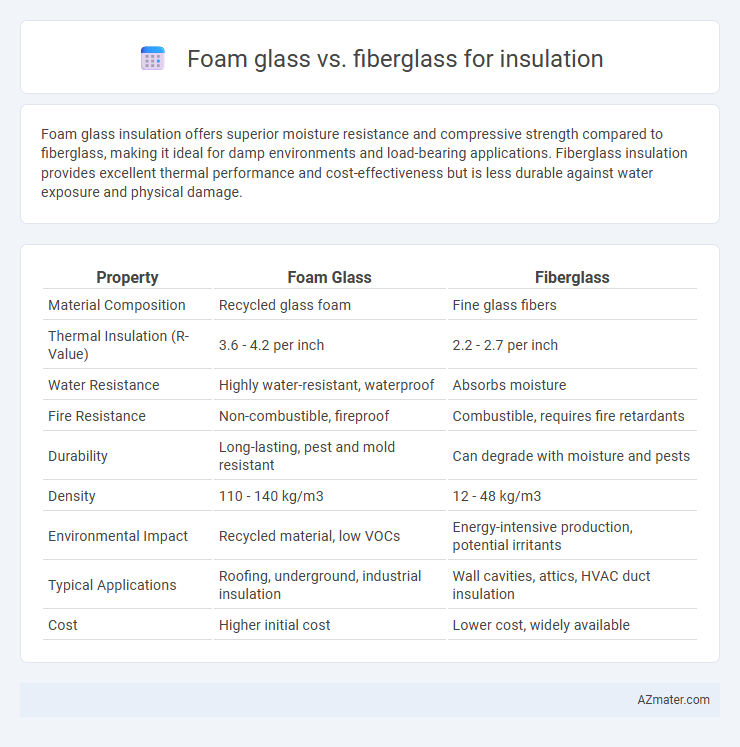Foam glass insulation offers superior moisture resistance and compressive strength compared to fiberglass, making it ideal for damp environments and load-bearing applications. Fiberglass insulation provides excellent thermal performance and cost-effectiveness but is less durable against water exposure and physical damage.
Table of Comparison
| Property | Foam Glass | Fiberglass |
|---|---|---|
| Material Composition | Recycled glass foam | Fine glass fibers |
| Thermal Insulation (R-Value) | 3.6 - 4.2 per inch | 2.2 - 2.7 per inch |
| Water Resistance | Highly water-resistant, waterproof | Absorbs moisture |
| Fire Resistance | Non-combustible, fireproof | Combustible, requires fire retardants |
| Durability | Long-lasting, pest and mold resistant | Can degrade with moisture and pests |
| Density | 110 - 140 kg/m3 | 12 - 48 kg/m3 |
| Environmental Impact | Recycled material, low VOCs | Energy-intensive production, potential irritants |
| Typical Applications | Roofing, underground, industrial insulation | Wall cavities, attics, HVAC duct insulation |
| Cost | Higher initial cost | Lower cost, widely available |
Understanding Foam Glass and Fiberglass Insulation
Foam glass insulation consists of crushed glass combined with a foaming agent, resulting in a rigid, moisture-resistant material ideal for thermal and acoustic insulation in harsh environments. Fiberglass insulation is made of fine glass fibers spun into mats or batts, providing excellent thermal performance and sound absorption, commonly used in residential and commercial buildings. Both materials differ in durability, moisture resistance, and installation methods, influencing their suitability for specific insulation applications.
Material Composition and Manufacturing Process
Foam glass insulation is made from crushed glass powder fused into a cellular structure through high-temperature kiln processing, resulting in a rigid, non-combustible material with excellent moisture resistance. Fiberglass insulation consists of fine glass fibers spun from molten glass, formed into mats or batts through a mechanical or wet layup process, providing flexibility and high thermal performance. The manufacturing process of foam glass emphasizes thermal fusion and foaming agents, while fiberglass relies on fiber spinning and binding resins.
Thermal Performance Comparison
Foam glass insulation offers superior thermal performance with a low thermal conductivity typically around 0.04 W/m*K, providing excellent resistance to heat transfer and moisture. Fiberglass insulation, commonly having a thermal conductivity between 0.035 and 0.045 W/m*K, performs well but can lose effectiveness when compressed or exposed to moisture. The closed-cell structure of foam glass ensures long-term stability and consistent insulation value, outperforming fiberglass in environments requiring durability and moisture resistance.
Moisture and Water Resistance
Foam glass insulation offers superior moisture and water resistance compared to fiberglass, as its closed-cell structure prevents water absorption and inhibits mold growth. Fiberglass insulation tends to retain moisture, which can compromise its thermal performance and promote microbial proliferation. Choosing foam glass enhances durability and maintains insulation effectiveness in damp or wet environments.
Fire Resistance and Safety
Foam glass insulation offers superior fire resistance compared to fiberglass, as it is non-combustible and can withstand temperatures above 1000degF without releasing toxic fumes. Fiberglass, while fire-retardant, may melt or degrade at high temperatures, potentially emitting harmful particles. Foam glass enhances safety in building applications by providing both thermal insulation and a durable, fireproof barrier.
Environmental Impact and Sustainability
Foam glass insulation offers superior environmental benefits due to its composition from recycled glass and non-toxic materials, resulting in a highly durable, moisture-resistant product with a lifespan exceeding 50 years. Fiberglass insulation, while effective in thermal performance, often contains formaldehyde and glass fibers that can pose health risks and challenges in disposal or recycling. Choosing foam glass reduces landfill waste and energy consumption associated with production and disposal, enhancing sustainability in building projects.
Durability and Lifespan
Foam glass insulation offers exceptional durability due to its resistance to moisture, fire, and pests, resulting in a significantly longer lifespan compared to fiberglass. Foam glass maintains structural integrity over decades, often exceeding 50 years without degradation, while fiberglass typically lasts 15 to 30 years before requiring replacement or maintenance. The non-combustible and impermeable properties of foam glass make it a superior choice for long-term insulation performance in harsh environments.
Installation Procedures and Ease
Foam glass offers a rigid, lightweight structure that is cut and fitted with precision, allowing for straightforward installation on flat or irregular surfaces without requiring additional support frameworks. Fiberglass insulation, available in batts or loose-fill form, requires careful handling and protective gear to prevent skin irritation, and its flexible nature enables easy fitting between studs and joists but may need vapor barriers and precise sealing to maximize effectiveness. The installation of foam glass is generally cleaner and less labor-intensive, while fiberglass demands more preparation and skilled workmanship to avoid gaps and ensure optimal thermal performance.
Cost Analysis and Return on Investment
Foam glass insulation typically has a higher upfront cost compared to fiberglass but offers exceptional durability, moisture resistance, and fireproof properties, leading to lower maintenance and replacement expenses over time. Fiberglass is more affordable initially and widely used but may require frequent replacement and careful handling due to its susceptibility to moisture damage and reduced thermal efficiency. Evaluating return on investment, foam glass insulation often proves more cost-effective long-term in industrial or high-moisture environments, while fiberglass may provide quicker savings in residential settings with moderate insulation needs.
Applications: Best Uses for Foam Glass vs Fiberglass
Foam glass excels in applications requiring moisture resistance, durability, and thermal insulation, making it ideal for industrial settings, cryogenic storage, and below-grade or submerged environments. Fiberglass is best suited for residential and commercial wall cavities, attics, and HVAC systems due to its flexibility, ease of installation, and excellent thermal and acoustic insulating properties. Choosing between foam glass and fiberglass depends on specific requirements such as exposure to water, compressive strength, and ease of handling in construction and industrial applications.

Infographic: Foam glass vs Fiberglass for Insulation
 azmater.com
azmater.com